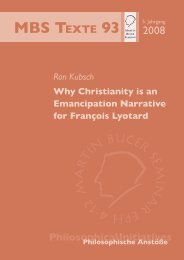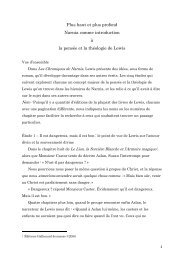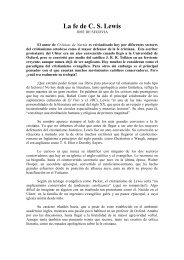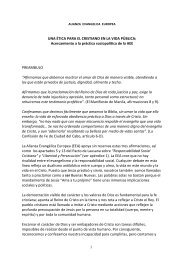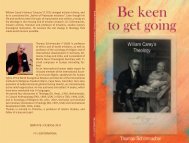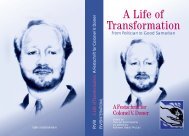Calvin and Missions - World Evangelical Alliance
Calvin and Missions - World Evangelical Alliance
Calvin and Missions - World Evangelical Alliance
Create successful ePaper yourself
Turn your PDF publications into a flip-book with our unique Google optimized e-Paper software.
Simmons: John <strong>Calvin</strong> <strong>and</strong> <strong>Missions</strong>: A Historical Study (2002) 197<br />
was translated into the Hungarian language. Third, in 1536, King Soliman<br />
the Magnificent threatened Hungary. In 1526, King Louis went to meet<br />
him at Mohácz with only 27,000 men – a mere fraction of the Turkish<br />
army. The result was a massacre, <strong>and</strong> king Louis fled the country, leaving a<br />
power vacuum in Hungary. James Wylie continues the story:<br />
Two c<strong>and</strong>idates now contested the scepter of Hungary – John Zapolya,<br />
the unpatriotic gr<strong>and</strong>ee who saw his king march to death, but sat still in his<br />
castle, <strong>and</strong> the Archduke Ferdin<strong>and</strong> of Austria. Both caused themselves to<br />
be crowned, <strong>and</strong> hence arose a civil war, which, complicated with occasional<br />
appearances of Soliman upon the scene, occupied the two rivals for<br />
years, <strong>and</strong> left them no leisure to carry out the persecuting edicts. In the<br />
midst of these troubles Protestantism made rapid progress. Peter Perenyi, a<br />
powerful noble, embraced the Gospel, with his two sons. Many other magnates<br />
followed his example, <strong>and</strong>-settled Protestant ministers upon their<br />
domains, built churches, planted schools, <strong>and</strong> sent their sons to study at<br />
Wittenberg. The greater number of the towns of Hungary embraced the<br />
Reformation. 381<br />
Whatever the reasons, By the 1550’s, <strong>Calvin</strong>ism was becoming established<br />
in Hungary. In 1557 <strong>and</strong> 1558 a synod was held which resulted in<br />
the Hungarian Confession, exhibiting a distinct <strong>Calvin</strong>istic theology. In<br />
1567, at the Synod of Debrecen, the Hungarian Reformed Church adopted<br />
the Heidelberg Catechism <strong>and</strong> the Second Helvetic Confession. 382 <strong>Calvin</strong>ism<br />
has survived in Hungary despite much persecution, though during the<br />
seventeenth century the Counter Reformation reclaimed many converts to<br />
the Catholic faith. However, at the turn of this century, two-thirds of the<br />
evangelical churches of Hungary were <strong>Calvin</strong>istic in origin. 383 Of the<br />
nearly 2.6 million people associated with Christian denominations in Hungary<br />
today (population 10.5 million), approximately 2 million are affiliated<br />
with the Reformed Church. 384<br />
Overseas <strong>Missions</strong> in Brazil<br />
Protestants were greatly hindered in any attempt to bring the gospel<br />
overseas. Prior to 1588 (when the Spanish Armada was defeated) the Span-<br />
381<br />
James Aitken Wylie, Protestantism in Hungary <strong>and</strong> Transylvania, vol. 3, bk. 20.<br />
382<br />
Encyclopedia Britannica, s.v. “Reformed Church in Hungary.” Online:<br />
www.britannica.com.<br />
383<br />
Ibid., 395.<br />
384<br />
Patrick Johnstone, Operation <strong>World</strong> (Gr<strong>and</strong> Rapids: Zondervan, 1993), 268.




